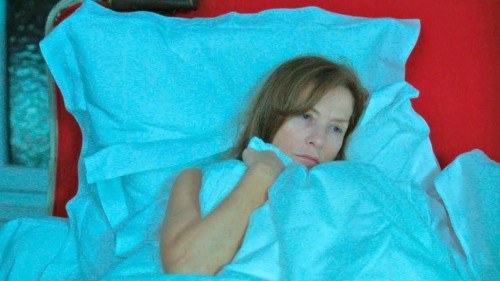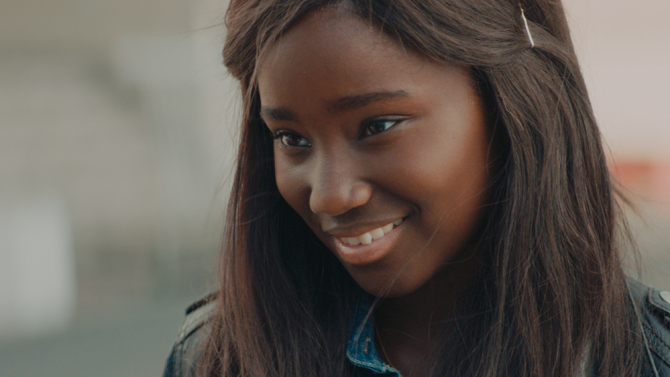This guest post by Laura Minor appears as part of our theme week on Violent Women.
Named one of TIME magazine’s “10 most ridiculously violent films” [1], Alexandre Aja’s 2003 slasher High Tension (originally titled Haute Tension) is a visceral delight, a horrific spectacle of generic excess. Yet with the film’s synopsis describing the leading character, Marie, as a “beautiful young Frenchwoman,” High Tension could have easily been seen in GQ’s article “The 25 Sexiest Violent Women in Film” [2]. Rather than pander to the male gaze, Aja decides to reject these scopophilic pleasures in favour of championing female subjectivity, but he also chooses to reject heteronormativity by having the lesbian desires of Marie drive the plot of the film. Interestingly, it is these desires and subjective experiences that both initiate the use of violence and intensify the representation of violence throughout.
Before examining the film’s treatment of gender, sexuality and violence, however, its basic narrative needs to be understood. High Tension revolves around Marie (Cécile De France) and Alex (Maïwenn Besco), two college students who travel to Alex’s parents’ farmhouse in the French countryside so that they can relax and study in peace. After arriving at the farmhouse and settling down for the night, Marie begins masturbating in bed, presumably fantasising about Alex after she inadvertently spies on her in the shower. The killer arrives simultaneously and begins brutally massacring Alex’s family without reason. He then abducts Alex after blinding her, and Marie consequently emerges as the Final Girl, the protagonist who must save the day. What ensues is a cat-and-mouse chase, with the killer eventually hunting down Marie for the archetypal finale – a one-on-one confrontation between the protagonist and antagonist. However, when Marie ends the killer’s life, it is revealed that she is in fact the killer, thereby rupturing the classical protagonist/antagonist relationship.
Aja’s ending has received strong, negative criticism for its twist, but the purpose of this ending is to not merely shock. Of course, if we read it through a conservative lens, then Marie’s transgressions serve to maintain and perpetuate heterosexist discourse, as the lesbian protagonist is revealed to be the monster; she is the outsider who has destroyed the nuclear family. Indeed according to Harry M. Benshoff,
both movie monsters and homosexuals have existed chiefly in shadowy closets and when they do emerge from these proscribed places into the sunlit world they cause panic and fear. Their closets uphold and reinforce binaries of gender and sexuality that structure Western thought. To create a broad analogy, monster is to “normality” as homosexual is to heterosexual [3].
While this has been true for past representations, Marie’s psychotic creation of “Le Tueur” (meaning “The Killer” in English) complicates the idea that she is the tangible monster. This unnamed, unidentifiable man is the one who has committed cinematic sadism, and although the monster is a manifestation of Marie’s latent desires, he also personifies the fear and anger she feels about her own sexuality. This is implied at the beginning of the film through dialogue and lighting – when Marie and Alex arrive at the farmhouse, Alex tells Marie she’ll “end up an old maid” because of her lack of interest in men. Understandably, Marie reacts with dejection. Her face is deliberately shadowed by the darkness outside as she solemnly says “Don’t start with that”. Indeed though subtle, it is obvious that Alex’s ingrained, societal beliefs have affected her deeply, the feeling that she is an outcast, that she should settle down and find a nice husband. To have her best friend and love interest speak in such a way does not excuse murder (that much is obvious), but it could explain why Marie constructs an individual that represents heteronormativity (a white, heterosexual middle-aged man) committing these violent acts instead.
This fabricated part of her psyche, in some ways, conforms to Halberstam’s notion of “imagined violence,” which is defined as “the fantasy of unsanctioned eruptions of aggression” [4]. More specifically, Halberstam argues that “imagined violence does not advocate lesbian or female aggression but it might complicate an assumed relationship between women and passivity or feminism and pacifism” [4]. To imagine the possibility of female violence is to create a new source of pleasure for women, as resistance on-screen is a reaction against gender/sexuality-based prejudices. High Tension, however, takes this level of imagination to a disturbed and distorted level, as Marie/Le Tueur brutally kill an innocent family. Yet it could be argued that this (fe)male violence symbolises Marie’s anger, or more specifically, Marie’s inability to control the rage she feels about heteronormativity upholding “traditional family values” (these being strictly defined gender roles and heterosexuality). After all, she cannot control this part of her consciousness, as she desires to kill this part of her consciousness and rescue Alex.
The “imagined violence” against the heteronormative male within is a significant, internal battle that culminates in Marie defeating Le Tueur with a fence post covered in barbed wire. She uses this aggressive, phallic symbol to “challenge powerful white heterosexual masculinity and create a cultural coalition of postmodern terror” [4], the most significant aspect of “imagined violence.” Of course, such a reading is not so simple in a film that constructs a schizophrenic narrative and a schizophrenic character, but High Tension is aware of its supposed inconsistencies, which again can be seen in its ending. Before Le Tueur’s death, he wields his chainsaw in an attempt to kill Alex, only for his weapon to be replaced by Marie’s sweet and soft kiss. The act of (fe)male violence and gentleness in this scene unifies the binaries of masculinity and femininity, and therefore complicates the definitions of monstrousness and gender. For this reason, as Joshua Cohen has argued, High Tension “poses somewhat of a problem for the critic interested in allocating monstrosity into a neatly defined category such as masculine or feminine. Rather, High Tension requires a spectator whom assumes that gender is a subject that transcends the limitations of binary oppositions” [5].
Indeed because Aja has forced us to intimately identify with Marie and then Alex via specific camerawork, these acts of violence are intensified, but so are subtle character movements. The final scene is particularly significant in this regard; when Marie is in a psychiatric hospital, Alex watches her through a one-way mirror and extends her hand to the screen, almost as if she is visiting a lover in prison. Here we are forced to identify with Alex as the camera slowly follows her hand, and when she asks a doctor whether Marie can see her through the mirror, it is clear that she is also asking this question for us, the extra-diegetic spectators. Marie answers this question soon after. No, she cannot see Alex, she can sense her, and by extension she can sense the audience. Her face beams with delight as she opens her arms in a sudden forceful yet loving gesture, and the camera lurches back in horror with Alex, thus forcing us as spectators to mimic these movements. The jerky, violent actions of Marie are therefore ambiguous. Whilst we are initially drawn to her by the placement of Alex’s hand, we are then pushed away by her affection/violence. Perhaps it would be reading too much into the ending to view Alex’s hand gesture as an act of repressed sexuality, but it is interesting that Alex, now the audience surrogate, is both drawn to and disgusted by Marie’s affectionate/violent disposition. In this regard, High Tension offers no concrete resolution as to how we should view the protagonist. Instead, it offers multiple readings of gender, sexuality, and violence that typify our contemporary, heterogeneous culture. Indeed despite the monstrous actions of Marie, underneath the surface, Alex and the audience know that she cannot be simplistically defined – it is why we have returned to her at the hospital.
Overall, to define High Tension as conservative would be problematic, as we would have to ignore the ways in which it has transcended stereotypical ideals of gender and sexuality through acts of violence, whether these acts be blatant (such as the aggressive methods of murder) or subtle (such as the sudden erratic movements of Marie). It is certainly clear that the narrative does not advocate male or familial genocide as a strategy for achieving women’s emancipation. If anything, the film seeks to place itself in-between the rich, textured spaces of female subjectivity and identity, spaces that are not always straightforward, rational or prototypical.
Footnotes
[1] Sanburn, Josh. “Top 10 Ridiculously Violent Movies.” TIME., September 2, 2010. http://entertainment.time.com/2010/09/03/top-10-ridiculously-violent-movies/.
[2] “The 25 Sexiest Violent Women in Film”. GQ., June 30, 2009. http://www.gq.com/gallery/list-sexy-women-movies-violent-angelina-jolie-halle-berry-jessica-alba-slideshow.
[3] Benshoff, Harry M (1997). Monsters in the Closet: Homosexuality and the Horror Film. Manchester and New York: Manchester University Press.
[4] Halberstam, Judith (1993). ‘Imagined Violence/Queer Violence: Representations of Rage and Resistance’. Social Text 37, pp.187-201.
[5] Cohen, Joshua. ‘‘’Will You Still Love Me in the Morning?’: Gender Representation and Monstrosity in Alexandre Aja’s High Tension.” Fear, Horror, and Terror, 2nd Global Conference. Oxford: United Kingdom, 2008. Print.
Laura Minor is currently undertaking a Master’s in Film and Television Studies. She runs a blog at lrjdmnr.wordpress.com where she discusses feminist media studies, film/television aesthetics and genre theory.












